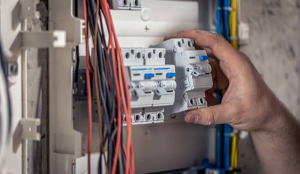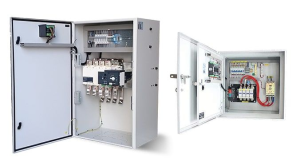Transfer Switch
Transfer switch are critical components in backup power systems, ensuring uninterrupted electricity supply during power outages or when switching between different power sources. These devices serve as the bridge between your primary power source (typically the grid) and a secondary power source (often a generator or alternative energy source). Transfer switches enable a smooth and safe transition, preventing power disruption and protecting sensitive equipment.
What Is a Transfer Switch?
A transfer switch is an electrical device that allows you to switch between two power sources seamlessly. It serves as a bridge between the primary power source (typically the utility grid) and a secondary power source (such as a generator or an alternative power supply). Transfer switches ensure a smooth and safe transition from one power source to another, preventing electrical backfeeding, which can damage equipment and pose safety hazards. Also, read about Remote Video Surveillance: All You Need to Know
Types of Transfer Switches
There are two main types of transfer switches:
Automatic Transfer Switch (ATS)
ATS systems are fully automated and can detect power outages.
When a power outage occurs, the ATS switches to the backup power source automatically.
ATS systems are commonly used in homes, businesses, and critical infrastructure to provide uninterrupted power.
Manual Transfer Switch
Manual transfer switches require human intervention to switch between power sources.
Users must physically move a lever or switch to transfer power.
Manual transfer switches are typically used in residential settings where backup power is less frequent or in situations where cost considerations favor manual operation.
Bypass Isolation Transfer Switch: These switches offer additional features, such as a bypass mechanism that allows for maintenance without interrupting power to the load.
How Transfer Switches Work
Transfer switches work by monitoring the availability and quality of the primary power source. When they detect an issue, such as a power outage or voltage irregularities, they initiate the transfer to the backup power source. This transfer occurs in a fraction of a second, ensuring that critical equipment and systems remain operational.
Key Benefits of Transfer Switches
Using transfer switches offers several advantages:
Seamless Power Transitions: Transfer switches ensure that your electrical systems do not experience interruptions during power source changes.
Protection for Sensitive Equipment: They prevent voltage surges and fluctuations, protecting sensitive electronics and appliances from damage.
Enhanced Safety: By preventing backfeeding, transfer switches eliminate the risk of electric shock to utility workers and maintain a safe electrical environment.
Automatic vs. Manual Transfer Switches
Automatic Transfer Switch (ATS): ATS devices are equipped with sensors that detect power interruptions. When an outage occurs, the ATS disconnects the load from the grid and connects it to the backup power source, all within a matter of seconds. When the grid power is restored, the ATS switches back to the primary source.

Manual Transfer Switch: Manual switches require an operator to physically move a lever or switch to transfer the load between power sources. While they offer more control, they rely on human intervention and may result in a brief interruption during the switch
Choosing the Right Transfer Switch
Selecting the appropriate transfer switch involves considering factors like the size of your backup power source, the load you need to support, and the type of transfer switch that suits your requirements.
Sizing Considerations
The transfer switch should be appropriately sized to handle the total load you want to support during an outage. Oversizing or undersizing can lead to problems.
Compatibility with Generators and Electrical Systems
Ensure that the transfer switch is compatible with your backup power source, whether it’s a generator or an alternative energy system. It should also integrate seamlessly with your existing electrical system.
Transfer Switch vs. Load Shedding
While transfer switches are essential for maintaining power supply, load shedding is another strategy used to manage electricity during peak demand or shortages.
Installation and Maintenance
It’s crucial to have transfer switches professionally installed to ensure they function correctly. Routine maintenance, such as testing and inspection, should be performed to verify their reliability.
Routine Maintenance for Optimal Functionality
Regular maintenance is essential to keep the transfer switch in peak working condition. This includes inspecting connections, testing the switch’s operation, and addressing any issues promptly.
Understanding the Differences
Transfer switches enable seamless power transitions between sources, while load shedding involves intentionally reducing power consumption to prevent grid overload. For More Interesting Information Visit Our Website: Byte Tech Solution
Appropriate Use Cases
Transfer switches are primarily used for backup power systems, while load shedding strategies are employed by utility companies to manage power distribution.

Conclusion
Transfer switches are essential components in backup power systems, guaranteeing uninterrupted electricity during outages and transitions between power sources. Whether in residential, commercial, or industrial settings, transfer switches play a vital role in maintaining power continuity and ensuring the reliability of electrical systems.A transfer switch is an electrical device used to safely and efficiently transfer power between two separate electrical sources, typically between the utility power grid and a backup power source like a generator. It ensures that power can be seamlessly switched from one source to another without the risk of backfeeding or damaging sensitive equipment
FAQs
1: What’s the difference between an automatic and a manual transfer switch?
Automatic transfer switches (ATS) detect power outages and switch to the backup power source automatically. Manual transfer switches require manual intervention to transfer power.
2: Can I install a transfer switch myself?
While it’s possible for experienced individuals, it’s strongly recommended to have a licensed electrician install a transfer switch to ensure safety and compliance with local codes.
3: Do I need a transfer switch for a portable generator?
Yes, using a transfer switch with a portable generator is essential to prevent backfeeding, which can be hazardous and damage your generator.
4: How often should I have my transfer switch inspected or maintained?
It’s advisable to have your transfer switch inspected and maintained annually to ensure it functions correctly when needed.
5: Can a transfer switch be used for both residential and commercial applications?
Yes, transfer switches are available in various sizes and configurations to meet the needs of both residential and commercial backup power systems.
